
100 Teaching Ideas that Transfer and Transform Learning
Expanding your Repertoire
Frank T. Lyman Jr.
- 188 pagine
- English
- ePUB (disponibile sull'app)
- Disponibile su iOS e Android
100 Teaching Ideas that Transfer and Transform Learning
Expanding your Repertoire
Frank T. Lyman Jr.
Informazioni sul libro
Expand your teaching repertoire with this unique collection of instructional ideas. Author Frank T. Lyman Jr., esteemed educator and creator of the Think-Pair-Share model, offers ways to help students think critically, encounter puzzling phenomena and seek explanations, think before responding, listen to responses from others, create their own questions, visualize a scene, employ problem-solving strategies, and more.
Appropriate for teachers of all grades and subjects, the ideas address the pursuit of true learning—wanting to learn, how to learn, and enabling to learn—and can easily be adapted and applied to a wide variety of contexts.
The book's format allows you to pick and choose activities for your own professional development journey and make them your own, so you can expand your teaching toolbox and bring more students to deeper levels of learning.
Domande frequenti
Informazioni
Appendix
FIGURE A.1 Classroom Motivation Wheel
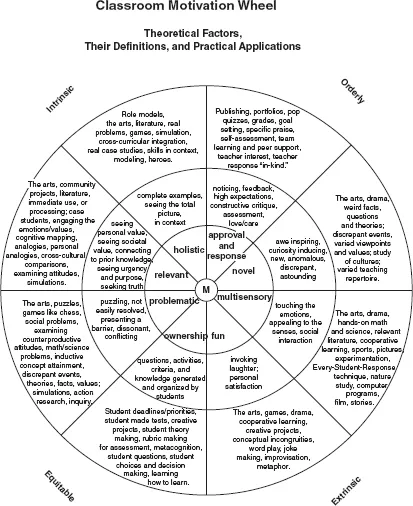
A look at various forms of motivation and practical applications.
FIGURE A.2 Problem-Solving Action Research Flow Chart

A problem-solving flowchart particularly useful for professional development and university purposes.
FIGURE A.3 Problem-Solving Action Research Thinking
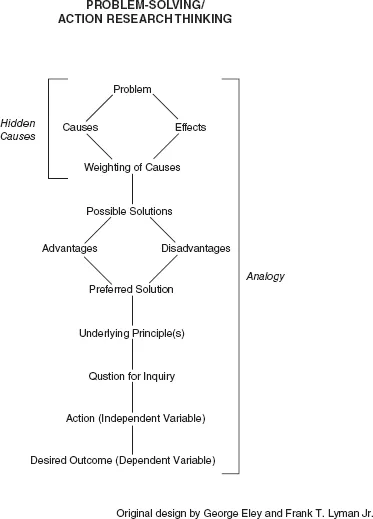
This cognitive path, or thinking heuristic, originated as a reflective tool to help beginning teachers solve classroom problems. The teachers were encouraged to go beyond the solution to a design for doing action research, thereby raising the attempted solution to the level of principle. Teachers discovered that by visualizing the steps, they could apply them in the middle of the classroom dynamic and solve problems “on the go.” Some teachers introduced the thinking path to students and used the heuristic with them to solve problems relevant to the content, the classroom community, or the community at large. Advanced or older students are able to carry the thinking through to the action research steps. Modeling by the teacher makes this work.
FIGURE A.4 Problem-Solution Template A
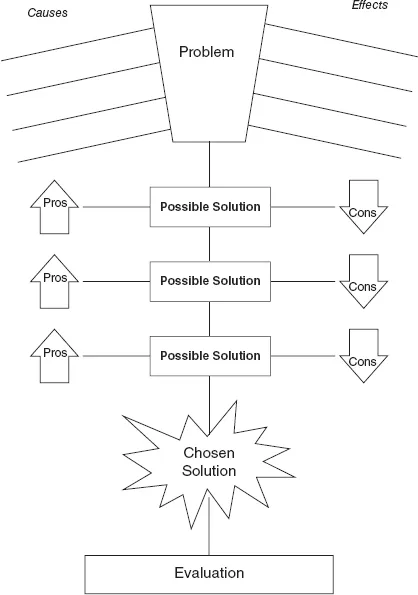
Teachers or students do the analysis on their own in writing and can then polish their work cooperatively with a partner or group.
FIGURE A.5 Problem-Solution Template B
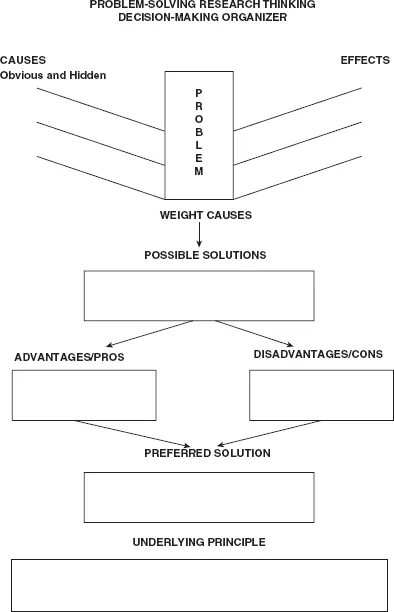
Alternate version. Teachers or students do the analysis on their own in writing and can then polish their work cooperatively with a partner or group.
FIGURE A.6 Mapping Designs
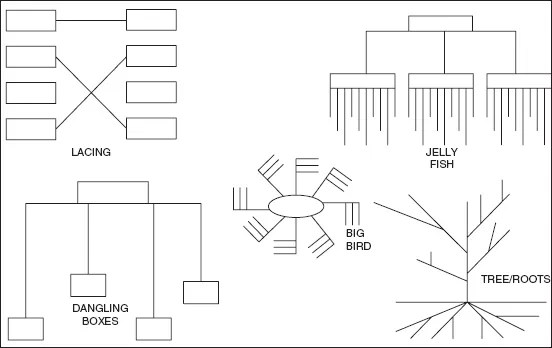
Five examples of visual maps.
FIGURE A.7 Concentric Circle ThinkLink

This cognitive map, or visual organizer, shape is included because of its almost universal utility in connecting thought, especially in concept development through analogy. It can be used with a class to construct theory about any cause-and-effect analyzable phenomenon, and students can use it as a note-taking device or as a blueprint structure for composition.
FIGURE A.8 Class Theory of Think Time

The class theory of Think Time grade 5 illustrates student-constructed theory.
FIGURE A.9 Decision-Making Organizer
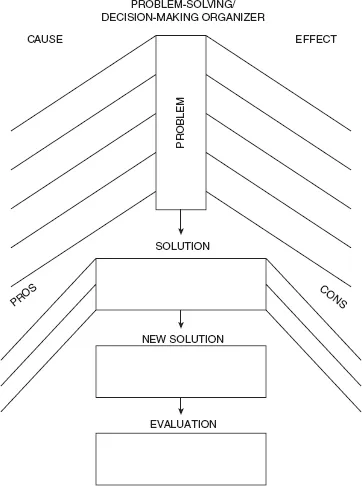
This decision-making organizer helps students analyze the causes and effects of the problem and weigh pros and cons of solutions.
FIGURE A.10 Class Theory of Learning
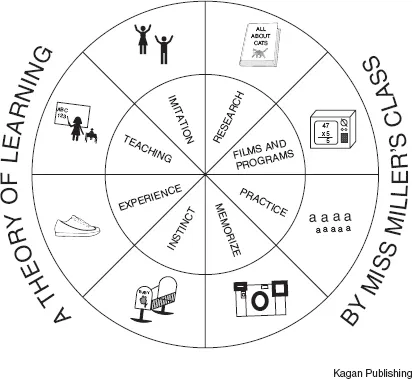
An example of Learning Theory Lab from Kim Miller’s Class.
FIGURE A.11 ThinkTrix Science
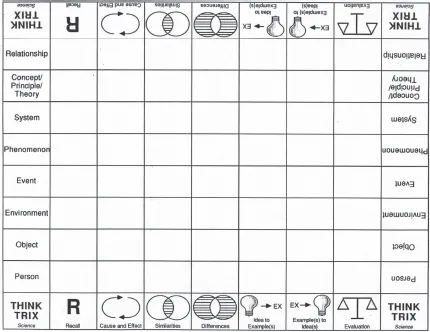
This two-sided grid serves as a desk format for two or more students to work cooperatively to discuss science or any subject, creating, classifying, and answering questions. ThinkTrix grids can be designed for any content area by changing the departure points.
FIGURE A.12 ThinkTrix Social Studies
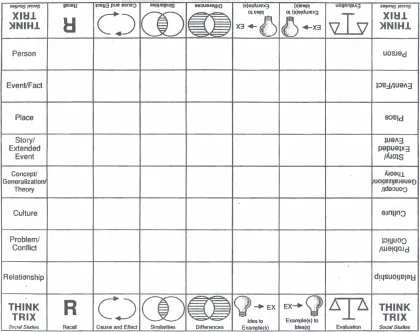
This two-sided grid serves as a desk format for two or more students to work cooperatively to discuss social studies or any subject, creating, classifying, and answering questions. ThinkTrix grids can be designed for any content area by changing the departure points.
FIGURE A.13 ThinkTrix Language Arts
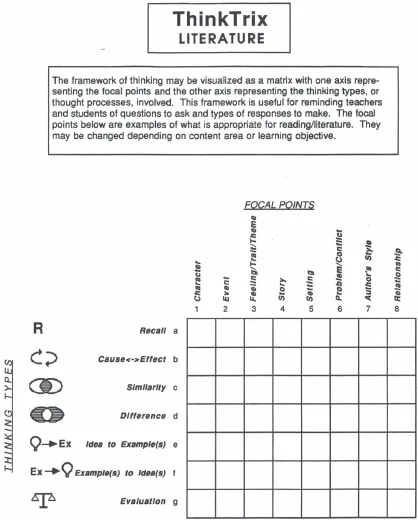
This is an alternate version, shown here with a literature/language arts example.
Note
- This ThinkTrix grid and the two-sided discussion grids (Figures A.11 and A.12) were designed by Belinda Miller and Sharon Vargo Olson
FIGURE A.14 The Reading Wheel
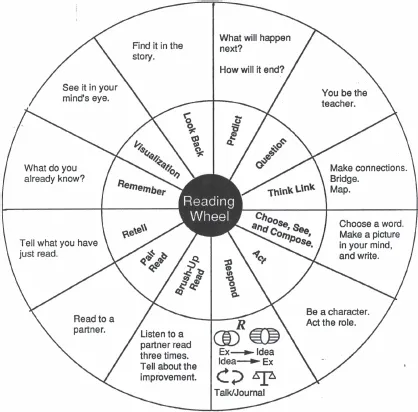
The reading wheel was designed originally to give students options during reading group as they waited for other students to finish silent reading. The teacher set the arrows on individual activities they could engage in as they waited. This technique was dubbed “concentric options.” Soon it became evident that the activities on the wheel were useful to remind the teacher of strategies for student response to the reading that could be employed at any time during the group discussion. The wheel was enlarged, enhanced through color and design, and displayed prominently.
FIGURE A.15 HOT! Handwriting
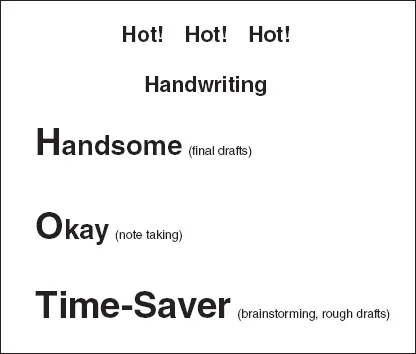
A reminder of when to focus on legible writing.
FIGURE A.16 Concept and Skill Development Planning Template
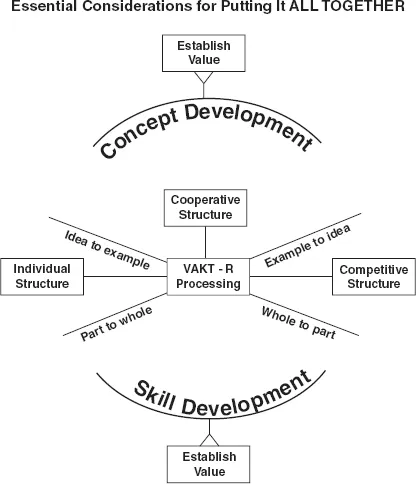
This design has the function of reminding the teacher to consider which strategy to use when teaching a concept or a skill. Should the concept be taught from the specific to the general or the reverse? Should the skill be introduced by its parts or by presenting the whole first? What is the value of the concept or skill? Should the concept or skill be learned by the individual in a cooperative group or competitively?